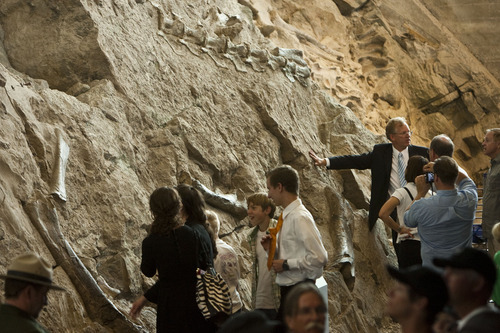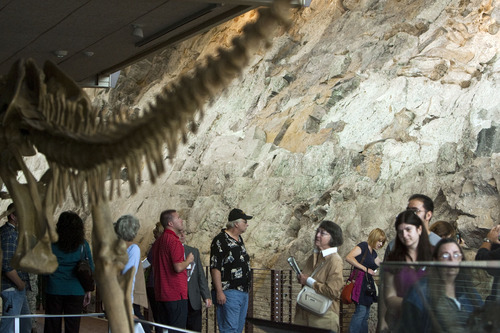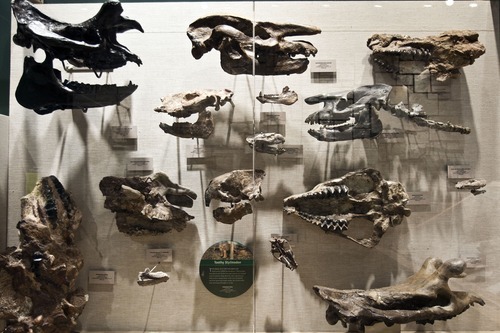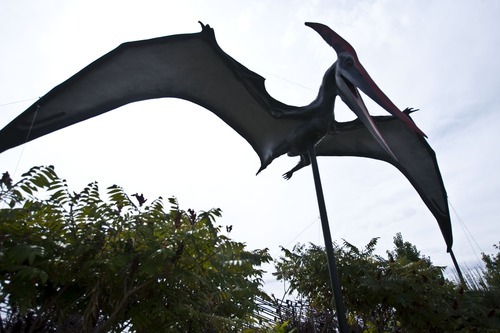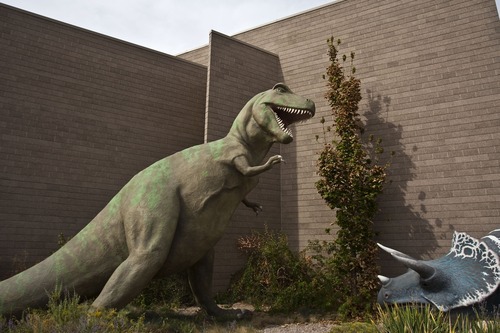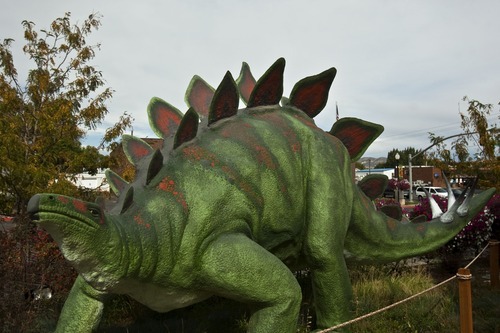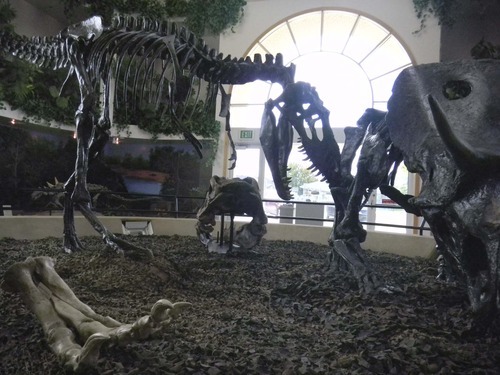This is an archived article that was published on sltrib.com in 2011, and information in the article may be outdated. It is provided only for personal research purposes and may not be reprinted.
For creatures that wandered through Utah millions of years ago, dinosaurs certainly are making news these days.
Whether paleontologists are announcing the discovery of a new species, or working a dig in places such as Hanksville, Moab, Emery County or the Uinta Basin, or buildings and exhibits are either being rebuilt or constructed from scratch, dinosaurs are enjoying a renaissance in Utah.
The state already featured what is billed as the world's largest display of mounted dinosaurs at the Museum of Ancient Life at Thanksgiving Point, the world's best collection of dinosaur tracks at the St. George Dinosaur Discovery Site at Johnson Farm and the densest concentration of Jurassic-aged dinosaurs ever found at the Cleveland-Lloyd Dinosaur Quarry in Emery County.
In all, there are 13 facilities that display dinosaur fossils, bones or recreations, and there are many sites on public lands where paleontologists are opening new digs and species are being discovered.
"Utah is so famous for our landscape and our snow, but we are also really famous for our dinosaurs," said Tim Lee, a designer for the new Natural History Museum of Utah. "As a state, our educational institutions are starting to realize that. People outside of Utah are interested in that. We have an amazing geologic record of time. These dinosaurs once populated our state."
New and restored facilities that are already complete or coming on line in the near future will allow dinosaur enthusiasts to gain even more knowledge about these ancient reptiles.
At Dinosaur National Monument near Vernal, the famous Quarry Wall filled with about 1,500 exposed dinosaur bones representing 400 creatures reopened last week for the first time since 2006. The building protecting one of the world's most famous dinosaur sites has been restored and improved with better access and interpretive exhibits.
The Natural History Museum of Utah will be opening its new $100 million state-of-the-art facility on Salt Lake City's east bench on Nov. 18. It will include a "Past Worlds Zone" to display some of its famous dinosaur collection.
With a $1.5 million loan from the Uintah County Special Service Impact District, ground will soon be broken on a new laboratory and repository for eastern Utah dinosaur bones as part of the Utah Field House of Natural History State Park facility in Vernal. The facility could be ready for use as soon as next spring.
The Utah State University Eastern Prehistoric Museum — formerly the CEU Museum — in Price is reworking its main dinosaur exhibit and its famous Utahraptor to reflect new trends and discoveries in the field of paleontology.
"Anything new in the world of dinosaurs can cause a buzz," said Christine Trease, director of public relations for the Utah State University Eastern Prehistoric Museum.
In Utah, that buzz is almost a roar right now.
The excitement started with the reopening of the Quarry Exhibit Hall and new visitor center at Dinosaur National Monument last week. The quarry wall allows visitors to see the dinosaur bones uncovered but still embedded in the rock in which they were found. The quarry has produced fossils from all four major late-Jurassic dinosaur groups: plant-eating sauropods, stegasaurs, ornithopods and flesh-eating theropods.
Veteran monument paleontologist Dan Chure, who first came here in 1979, called the wall "a library of dinosaur bones. Coming here is a pilgrimage for many schools. ... This is the heart and soul of Dinosaur."
In nearby Vernal, Steve Sroka, manager of the Utah Field House of Natural History State Park, said the new laboratory and repository planned to be a part of that facility will consist of 12,000 square feet of space and have a viewing area where the public can watch paleontologists prepare fossils and exhibits. Many of the fossils are found in the area.
Then there is the new Natural History Museum of Utah, one of the most expensive facilities of its kind to open in the state. Its dinosaur exhibit will include a 30-foot-long "trophy wall" featuring about 15 ceratopsans — horned dinosaurs — many of which were discovered in Utah.
An interactive exhibit on the Cleveland-Lloyd Dinosaur Quarry will ask visitors to help solve the mystery of why there are so many dinosaurs on that site. Kids can enjoy two dino digs, one inside and a large 30-foot by 15-foot outdoor dig. Some of the exhibits will have scent stations, which offer visitors a chance to immerse themselves in the world of dinosaurs.
According to Lee, there is a two-floor ramped portion of the exhibit where visitors can look at a giant barosaurus in the eye then walk down to the first level and look up at the dinosaur.
In Price, paleontologist and museum director Ken Carpenter said scientists are finding more about what the Utahraptor — originally found near Moab — looked like. Because this dinosaur is one of the museum's icons, scientists want to portray it accurately. Carpenter said the hope is to have the Utahraptor back on display for the holidays.
In addition, Carpenter and his staff are reworking "the pit" exhibit featuring four dinosaurs. One of the highlights is an allosaurus, which he believes is partially made of real bones and partially from fabricated bones. He wants to expose the bones.
Other dinosaurs in the exhibit are also being worked on, a process visitors can watch as it happens.
The bottom line for dinosaur lovers is that Utah is a hotbed of both discovery and new, state-of-the-art exhibits. For a young child fascinated by the ancient creatures or a curious adult looking at new takes on old dinosaurs, this is a great time to be interested in dinosaurs found in Utah.
wharton@sltrib.com Twitter: @tribtomwharton
—
Utah Dinosaur Sites
Ogden's George S. Eccles Dinosaur Park
Location • Mouth of Ogden Canyon.
Hours • Gate open Monday through Saturday, 10 a.m. to 5 p.m. Grounds open to 6 p.m. Closed Sunday.
Admission • Adults $7; Seniors 62 and over $6; Students 13-17 $6; Children 2-12 $5; Infants 1 and under free.
What's there • More than 100 dinosaur sculptures can be found, many of them outside and enhanced with sound. An emphasis was placed on dinosaurs indigenous to Utah. The Elizabeth Dee Shaw Stewart Museum offers dinosaurs and new facts and includes a laboratory where visitors watch paleontologists work. There is a gift shop, cafe and hands-on activities.
Website • http://www.dinosaurpark.org.
Natural History Museum of Utah
Location • Research Park near Red Butte Garden, Salt Lake City
Hours • This new museum is scheduled to open to the public Nov. 18 with hours from 10 a.m. to 5 p.m. seven days a week and extended hours to 9 p.m. on Wednesdays.
Admission • Not determined yet.
What's there • Museum officials are being mum on what the new dinosaur exhibits will look like but this much is known. The museum's collection includes Pleistocene, the Jurassic Cleveland-Lloyd dinosaur collections and materials from the Long Walk Quarry in central Utah. Expect to see classic dinosaurs from the Late Jurassic including fossils of Allosaurus, Ceratosaurus, Stegosaurus and Camarasaurus. Recent additions also come from the Grand Staircase-Escalante National Monument and Manti-LaSal National Forest.
Website • http://www.umnh.utah.edu/
The Museum of Ancient Life at Thanksgiving Point
Location • 3003 N. Thanksgiving Way, Lehi
Hours • Monday through Saturday, 10 a.m. to 8 p.m.
Admission • $10 adults; $8 child 3 to 12; $8 seniors 65 and over. Add $5 to adult and $4 to child and senior admission for movie and exhibits.
What's there • The museum bills itself as being the world's largest display of mounted dinosaurs. Hands-on displays where visitors can touch dinosaur bones, experience an erosion table or try a fossil dig are popular. There are 50 different interactive displays and 60 complete skeletal displays of dinosaurs. Guests can watch paleontologists at a lab within the museum. A 3D theater featuring a six-story large format movie screen is part of the museum.
Website • http://www.thanksgivingpoint.org.
BYU Museum of Paleontology
Location • 1683 N. Canyon Road, Provo
Hours • Monday through Friday, 9 a.m. to 5 p.m.
Admission • Free, donations accepted,
What's there • The 5,000-square foot museum was built to prepare, display and house the rock and dinosaur fossils collected by Dr. James Jensen and his crews from various locations in Utah, Colorado and Wyoming. The emphasis is on the Jurassic Period.
Website • http://cpms.byu.edu/ESM/information.html
Hutchings Museum
Location • 55 N. Center, Lehi
Hours • Tuesday through Saturday, 11 a.m. to 5 p.m.
Admission • Adults $4, children 3-18 $3; seniors $3, scouts $2.
What's there • There is an eclectic mix of things to see at the museum. Dinosaur buffs can see dinosaur bones and a tusk from a wooly mammoth in the fossil and shell room.
Utah Field House of Natural History
Location • 469 E. Main, Vernal
Hours • 9 a.m. to 5 p.m., Monday through Saturday
Admission • $6 adults, $3 seniors, $3 children, children under 5 free
What's there • Exhibits in the 22,000-square-foot museum cover nearly three billion years of earth history as seen in the surrounding area. The emphasis here is on eastern Utah. Exhibits include fossils, paintings, Native American life, There is a natural history hall with examples of local animal life. Kids especially enjoy seeing the 17 full-size replicas of prehistoric dinosaurs in the outdoor exhibit., including a 20-foot-tall Tyrannosaurus and a horned Triceratops. There is also a theater and gift shop. The museum rotunda features a 90-foot-long Diplodocus skeleton. Some hands on exhibits are available.
Dinosaur National Monument
Location • Jensen
Hours • 9 a.m. to 5 p.m.,
Admission • $10 per vehicle for seven days, $5 per person for someone on a motorcycle or bicycle.
What's there • After being closed since 2006, the famous Quarry Exhibit Hall with its wall of exposed dinosaur fossils reopened to the public last week. The building protecting the dozens of fossils is accessible, has two levels and contains some new interpretive displays. In addition, the new Quarry Visitor Center also opened. It features exhibits, a theater and bookstore and serves as the departure point for shuttles to the Quarry Exhibit Hall. During the off-season, park staff will provide access to the Quarry through car caravans. For information on times of the Quarry tours, call 435-781-7700.
Website • http://www.nps.gov/dino.
USU Eastern (formerly CEU) Prehistoric Museum
Location • 155 E. Main Street, Price
Hours • 9 a.m. to 5 p.m., Monday through Saturday (closed Sundays)
Admission • $5 adults, $4 seniors, $2 children 2-12, $15 family pass.
What's there • The museum is divided up into two major halls, one for archaeology and the other for paleontology. A dinosaur "pit" in the middle of the paleontology hall contains dinosaurs from the Jurassic era collected from the nearby Cleveland-Lloyd dinosaur quarry, 25 miles south of Price. Paleontologists are currently reworking both the pit dinosaurs — some of which are in pieces — as well as the museum's famous Utah Raptor to reflect new discoveries. Dinosaurs in the pit include Allosaurus, the state veterbrate fossil of Utah, the long-neck sauropod Camarasaurus, Stegosaurus and Camptosaurus. There is a corner containing a number of hands-on activities for kids and a laboratory where visitors can watch working paleontologists.
Website • http://www.ceu.edu/museum/htm/
Museum of the San Rafael Swell
Location • 70 N. 700 East, Castle Dale
Hours • 10 a.m. to 4 p.m., Monday through Friday, 10 a.m. to 2 p.m. Saturday, closed Sunday.
Admission • Donation
What's there • This small but modern museum contains skeletons of albertosaurus, chasmosaurus, animantarx and the skull of tyrannosaurus rex. Beautiful murals by local artist Clifford Oviatt illustrate the dinosaur scenes. There are also exhibits of wild animals and early man in the museum collection as well as a gift shop. A display of famous Utah geologist William Lee Stokes also adds a personal touch.
Cleveland-Lloyd Dinosaur Quarry
Location • 30 miles south of Price near Elmo in Emery County
Hours • Closed for the season. Facility usually opens in late March and is open through the end of August.
Admission • $5 per person 16 and over. Free under 16. America the Beautiful, Golden Age and Golden Access passes accepted.
What's there • This actual working quarry has provided fossils for museums throughout Utah and the world. It contains the densest concentration of Jurassic-aged dinosaur bones ever found as well as the largest collection of allosaurus fragillis ever found. A visitor center contains about two dozen exhibits. A 200-yard trail takes visitors down to quarry buildings that contain fossils, some of which are in the process of being uncovered, as well as interpretive sites. Several interpretive trails are also available on site.
Museum of Moab (formerly Dan O'Laurie Museum)
Location • 118 E. Center Street, Moab
Hours • Through Oct. 31: 10 a.m. to 5 p.m., Monday through Friday, noon to 5 p.m. Saturday. Nov. 1-Feb. 28: Noon to 5 p.m., Monday through Saturday.
Admission • Suggested donation $5 per adult, $10 per family.
What's here • This museum tells the story of Grand Couonty with archaeological, geologic and historical display. Dinosaur-oriented exhibits include a replica of a plated ankylosaur, a sauropod backbone and imprints of tracks. Also ask here or at the Moab information center for information on places to see dinosaur tracks and bones on nearby public lands.
Website • http://www.moabmuseum.org
The Dinosaur Museum
Location • 754 S. 200 West, Blanding
Hours • Museum is open from April 15 to Oct. 15 from 9 a.m. to 5 p.m. Monday through Saturday.
Admission • $3 adults, $2 seniors, $1.50 seniors.
What's here • The curators are famous for discovering feathered dinosaurs and are experts in dinosaur skin. The museum presents a complete history of the world of dinosaurs, with an emphasis on creatures from around the world. Exhibits featuring dinosaurs in movies including historic posters and dinosaur eggs and babies are especially popular.
Website • http://www.dinosaur-museum.org
St. George Dinosaur Discovery Site at Johnson Farm
Location • 2180 E. Riverside, St. George
Hours • 10 a.m. to 6 p.m., Monday through Saturday, closed Sundays.
Admission • $6 adults 12 and older; $2 children 4 through 11, children under four free.
What's here • The museum consists of a 15,000 square foot facility designed to proect over 2,000 dinosaur tracks and 195 to 198-million year old fossils and geologic specimens. Some experts say this collection of tracks is unmatched anywhere else in the world. Visitors see the tracks including some with skin impressions, fossil fish, plants, dinosaur remains, invertebrates and sedimentary structures. A complete rare scelidosaurus was also found here and the museum is the only place in the Western Hemisphere were the 11-foot replica is on display.
Website • http://www.dinotrax.com. —
Dinosaur Diamond
The Dinosaur Diamond Prehistoric Highway is a national scenic byway that runs through "dinosaur country" in eastern Utah and western Colorado and connects many museums and dinosaur sites.
> dinosaurdiamond.org




